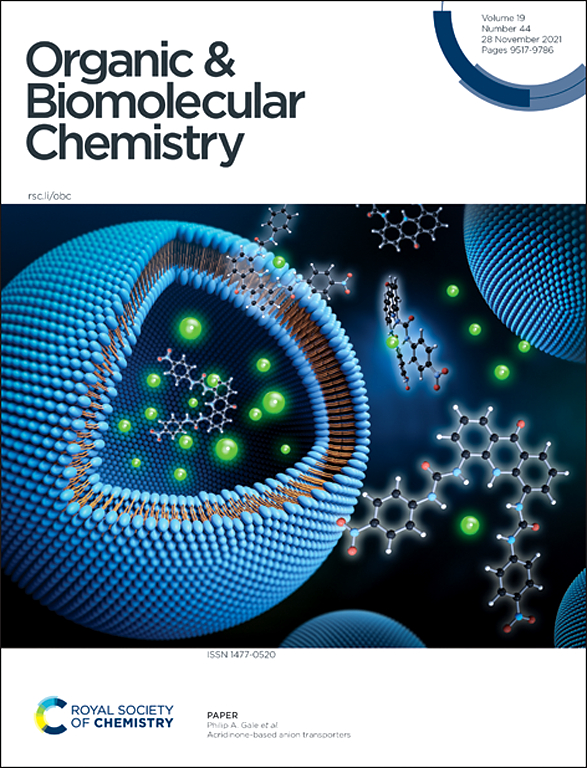Harnessing J-aggregation for dual-color cellular imaging with chromenoquinoline-benzimidazole dyes†
IF 2.7
3区 化学
Q1 CHEMISTRY, ORGANIC
引用次数: 0
Abstract
Fluorescence imaging has revolutionized the visualization of cellular structures and biomolecules due to its non-invasive nature and high sensitivity. Chromenoquinoline (CQ)-based dyes offer promising optical properties, yet their widespread application is hindered by aggregation-caused quenching (ACQ). In contrast, J-aggregates, characterized by distinctive photophysical properties, present a solution to ACQ. Here, we introduce a novel platform employing chromenoquinoline-benzimidazole (CQ-BI) dyes, capable of forming J-aggregates, for dual-color cellular imaging. The incorporation of a methyl group into the benzimidazole moiety enhances J-aggregate formation, leading to robust emission in both dilute solutions and aggregated states. Our study demonstrates that methyl moiety-modified CQ-BI derivatives enable simultaneous imaging of mitochondria and lipid droplets in living cells. This work underscores the potential of CQ-BI dyes for dual-channel fluorescence imaging, leveraging the unique properties of J-aggregation.

利用色喹啉-苯并咪唑染料的 J-聚合进行双色细胞成像。
荧光成像以其非侵入性和高灵敏度彻底改变了细胞结构和生物分子的可视化。基于色喹啉(CQ)的染料具有良好的光学特性,但其广泛应用却受到聚集淬灭(ACQ)的阻碍。相比之下,具有独特光物理特性的 J-聚集体则为 ACQ 提供了一种解决方案。在此,我们介绍了一种新型平台,该平台采用了能形成 J-聚集体的铬喹啉-苯并咪唑(CQ-BI)染料,用于双色细胞成像。在苯并咪唑分子中加入甲基可增强 J-聚集体的形成,从而在稀释溶液和聚集状态下都能发出强光。我们的研究表明,甲基修饰的 CQ-BI 衍生物可同时对活细胞中的线粒体和脂滴进行成像。这项工作强调了 CQ-BI 染料利用 J 聚合的独特性质进行双通道荧光成像的潜力。
本文章由计算机程序翻译,如有差异,请以英文原文为准。
求助全文
约1分钟内获得全文
求助全文
来源期刊

Organic & Biomolecular Chemistry
化学-有机化学
CiteScore
5.50
自引率
9.40%
发文量
1056
审稿时长
1.3 months
期刊介绍:
Organic & Biomolecular Chemistry is an international journal using integrated research in chemistry-organic chemistry. Founded in 2003 by the Royal Society of Chemistry, the journal is published in Semimonthly issues and has been indexed by SCIE, a leading international database. The journal focuses on the key research and cutting-edge progress in the field of chemistry-organic chemistry, publishes and reports the research results in this field in a timely manner, and is committed to becoming a window and platform for rapid academic exchanges among peers in this field. The journal's impact factor in 2023 is 2.9, and its CiteScore is 5.5.
 求助内容:
求助内容: 应助结果提醒方式:
应助结果提醒方式:


